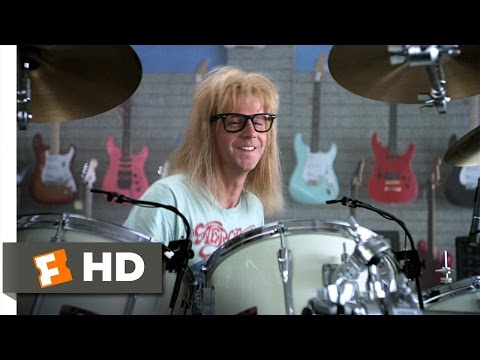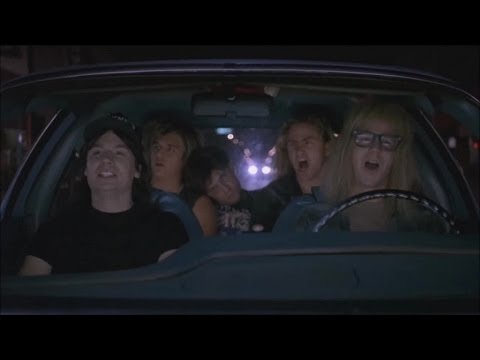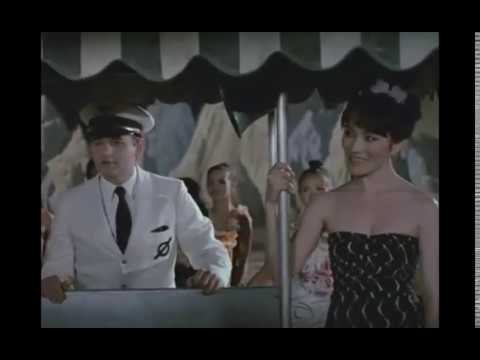There is genius within Penelope Spheeris’ “Wayne’s World” (1992).
If remembered as the best “Saturday Night Live” movie adaptation (which it is) or the film that brought Queen’s “Bohemian Rhapsody” back into the zeitgeist (more on that later), those alone would make for an impressive legacy.
Revisiting the film today is akin to putting on a vinyl album that still rocks hard and better than most everything else you’ll hear all year.

Audiences and critics were swept up in Spheeris’ film, though, at the time, it felt like a better-than-expected lark. Today, it’s a hall-of-famer comedy, a howler and a great movie about being young, clueless and hopeful, while surrounded by cynicism and a system that encourages us to sell out.
Mike Myers and Dana Carvey play Wayne and Garth, two metal-loving knuckleheads whose Aurora, Illinois cable access variety show has acquired a cult following. The duo obsess over women, rock and roll and, well, not much else, though they have a keen awareness of Kierkegaard and the hammy quality of “Oscar clips” to match their overall pop culture acumen.
Garth is infatuated by a diner patron (Donna Dixon), while Wayne falls in love with a talented musician and mega babe named Cassandra (Tia Carrere, typecast as a talented musician and mega babe).
When a smarmy TV executive (a pitch perfect Rob Lowe) slithers over to Wayne and Garth with a TV show pitch, the price of fame quickly leads to a crashing downside.

The second act lands on a subplot that is key to the whole thing: Wayne and Garth dream of mainstream success, refuse to sell out but, to their horror, find there’s no way to obtain the former without the latter.
Their show is sponsored by an arcade, run by a wholly out of touch owner (Brian Doyle-Murray) and becomes a slick, prepackaged version of its former self. It’s hilarious and horrifying to watch Wayne and Garth fail to ignite any spontaneity as corporate products, only finding themselves by mocking their owner on air.
Among the standout bits are the digs at Delaware, an unexpected meet and greet with Alice Cooper, Ed O’Neil’s hilarious monologue, and a sequence presented in subtitles that outpace the actors.
American comedies are rarely this playful, post-modern and deconstructionist.
These are the kind of absurdist touches you’d typically find in a work by Godard, not an early ’90s movie based on a “Saturday Night Live” skit about two morons running a public access TV show in their basement.
FAST FACT: “Wayne’s World” scored an impressive $121 million in its 1992 U.S. rollout. The sequel, released just one year later, saw severely diminished returns – $48 million haul.
Of course, the movie goes lowbrow and juvenile (hence its wide popularity during release and in subsequent years) but sometimes it isn’t the joke but the way the joke is told. There’s a consistency here, both in the stylishness of Spheeris’ helming and in the up-for-anything screenplay by Myers, Bonnie Turner and Terry Turner.
Myers has a sure hand on his character, evoking Wayne’s youthful idealism and angst, but also all too generous at demonstrating how stupid he is. As funny as Myers is here, Carvey’s even loonier turn is the real genius of the duo.
Garth is, literally, such a dreamer, but so delicate and incapable of matriculating life without Wayne, he comes across as Wayne’s living id and is nearly akin to being Wayne’s shadow.
RELATED: WHY MYERS’ ‘AXE MURDERER AGED BETTER THAN ‘AUSTIN POWERS’
The early scenes are full of throwaway jokes that could have been reversed in order but would have no effect on the plot. Most of these bits are surprisingly strong, from the first-person narration (which sometimes shifts) to the TV and movie parodies that materialize long enough to make their mark, then vanish before they begin to wear out their welcome.
It’s especially true of the “Scanners,” “Mission: Impossible, ”Laverne and Shirley” and “Terminator 2” gags).
“Wayne’s World” teases the conventions of movie cliches as often as it evokes them. There’s an ongoing commentary here about how crass commercialism deludes the integrity of raw artistry.
When Wayne and Garth hilariously react to the horror of their homegrown, no-frills and authentic TV show has become a corporate joke, the visual gags are a riot, but a real point has been made. Selling out is the easiest way to distance yourself from your “art,” whatever that might be.
This is why all other “SNL”-based movies have failed: “Wayne’s World” is calling them out for selling out: reprising a televised bit for 90-minutes and doing exactly what’s expected/demanded of you is why we have “A Night at the Roxbury,” “Superstar,” “It’s Pat,” “The Ladies Man” and a few others I won’t mention.
It’s worth noting that they got a real outsider, heavy metal documentarian Penelope Spheeris, to direct this and not Ivan Reitman. If anyone understands Wayne and Garth, let alone their adoration of Eddie Van Halen and a 1964 Fender Stratocaster, its Spheeris.
The eternally cool Penelope Spheeris has things to say about “Wayne’s World,” still the Queen of Hollywood rock satires on its 30th anniversary, + a look back at her ground-breaking “Decline of Western Civilization” punk trilogy @soundopinions. Listen up: https://t.co/EgixFw1hFS pic.twitter.com/IXedvC9qin
— Greg Kot (@gregkot) July 27, 2022
In terms of cinematic history, “Wayne’s World is the movie that made a generation sit up and become aware of “Bohemian Rhapsody” (long before the film of the same name, in which Myers made a too-on-the-nose cameo).
It remains the best “SNL” movie adaptation (no, the all-over-the-place “The Blues Brothers” has never earned that status) and, for a time, it was the top grossing American film directed by a woman.
Excellent!
I’ll admit to being only somewhat familiar with Queen in the 1990s, due to their contribution to the “Flash Gordon” and “Highlander” soundtracks. However, the “Bohemian Rhapsody” head banging scene, which begins as a joke and becomes a triumphant celebration of youthful zeal, catapulted my awareness of the band’s body of work.
It had a similar effect to millions of young people unfamiliar with the tune, which skyrocketed a 17-year-old song to the #2 spot.

In terms of late 20th century comedies about young people at a crossroads in their lives and a growing awareness of their fragile existence and uncertain futures, the bliss of the “Bohemian Rhapsody” scene is, no joke, akin to the scenes of nightly rapture in George Lucas’ “American Graffiti” (1973).
The only element that doesn’t work is Lara Flynn Boyle’s stalker character – the bit begins well enough, until it becomes cringe worthy in its mean spiritedness (amusingly, Flynn Boyle appears to be playing her role from “The Temp” a year earlier).
For those who know their “SNL” history, I’ll cite the number two best “SNL” movie (nope, still not “The Blues Brothers”): Tom Schiller’s “Nothing Lasts Forever,” the 1984 comic fantasy, presented in black and white and color, which was barely released and remains on the shelf after decades of building a strong cult following.
Schiller was a regular “SNL” contributor with his short films- the John Belushi-led “Don’t Look Back in Anger” is arguably his most famous.
Schiller wrote and directed “Nothing Lasts Forever,” in which Zach Galligan plays his stand-in, a young, idealistic art student who is immersed in SOHO performance art, flummoxed by the obstacles he faces and eventually takes a bus ride to the moon.
Bill Murray and (briefly) Dan Aykroyd have supporting roles, as do Eddie Fisher, Imogen Cocoa, Larry “Bud” Mellman and others in a wild supporting cast.

“Nothing Lasts Forever” is hilarious and crazily inventive, with an early Murray turn that makes it essential for his diehard fans. Due to shifting studio heads, rights issues and a perplexed MGM, the film has become a footnote, though it deserves a newfound recognition and acknowledgement as a masterpiece.
As for Spheeris’ film, it holds up better than you’d expected. Yes, there are era-specific gags but because the aim is absurdism and not always exact parody, many of these early ’90s shout outs (like a riff on a famous Grey Poupon ad) still hit their target, because they’re aiming for laughs rather than cultural relevancy.
Thirty years later, “Wayne’s World” remains most excellent.
The post ‘Wayne’s World’ at 30: Even More Excellent! appeared first on Hollywood in Toto.
from Movies – Hollywood in Toto https://ift.tt/9jICsaA

No comments:
Post a Comment